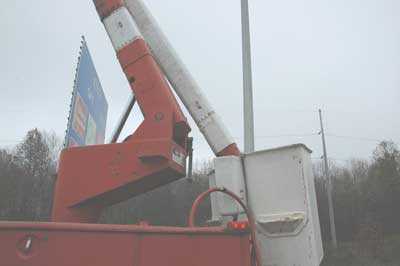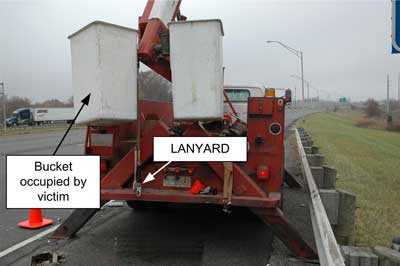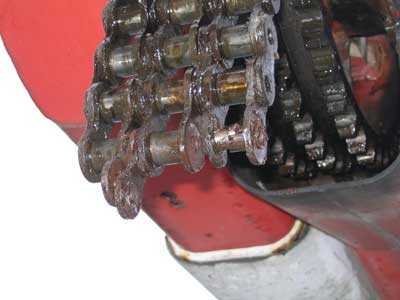Company Owner Dies From Fall After Upper Boom Failure On Aerial Lift - Ohio
NIOSH In-house FACE Report 2007-03
June 29 , 2007
Summary
On November 8, 2006, a 45 year-old owner of an electrical contracting company (the victim) died after falling approximately 9 feet to the road surface after the articulating boom of the aerial lift truck he was working from collapsed (photo 1). The victim, working at a height of approximately 35 feet, was changing light bulbs on overhead streetlights along a state highway. After replacing a bulb, the victim began lowering the boom. The upper boom actuating chain connecting the upper and lower boom sections broke and the upper section fell, striking the truck bed and ejecting the victim from the bucket. The victim struck his head and neck on the truck bed before landing on the road surface. A co-worker (the victim’s son), who witnessed the collapse from the ground, determined that the victim was unresponsive and began resuscitation efforts. A passing motorist called emergency medical service (EMS) personnel. The victim was transported to a local emergency department where he was pronounced dead.
 |
Photo 1: Aerial lift boom after incident. Note that the lower boom section remains elevated while the bucket-end of upper section is in a lowered position (photo courtesy of OSHA). |
NIOSH investigators concluded that, to help prevent similar occurrences, employers should:
- direct employees to immediately cease use of an aerial lift when it emits any unusual sounds, exhibits unusual motions, or fails to properly respond to controls
- strictly adhere to manufacturers' recommendations for maintenance and lubrication of aerial lift operating mechanisms
- ensure that qualified repair personnel conduct regular maintenance and inspections of aerial lifts
- maintain accurate records for boom maintenance and repair
Although the following recommendation does not apply to this specific incident, NIOSH concluded that as an additional measure of safety aerial lift operators should:
- ensure that work crews using aerial lifts include at least one ground person with the ability to contact emergency assistance if needed
Introduction
On November 8, 2006, a 45 year-old part-owner of an electrical contracting company (the victim) died after falling approximately 9 feet to the road surface after the articulating boom of the aerial lift truck he was working from collapsed. On November 8, 2006, the National Institute for Occupational Safety and Health (NIOSH), Division of Safety Research (DSR), was notified of the incident by the U.S. Department of Labor, Occupational Safety and Health Administration (OSHA). On December 19, 2006, NIOSH investigators conducted an investigation of the incident. The case was reviewed with the Assistant OSHA Area Director and the Compliance Officer assigned to the case. None of the co-workers who had witnessed the incident were available for interview by NIOSH investigators. A copy of the police report, transcript of the local fire department dispatch release, and the manufacturer's operation and maintenance manual were obtained and reviewed. OSHA provided photographs taken on the day of the incident.
Employer
The victim was the part-owner of an electrical contracting company that had been founded by his father in 1980. Approximately 60% of the company's contracts were for new streetlight construction while the remaining 40% were for streetlight maintenance and repair. The company had 12 employees working 10 hour shifts, four days per week. A streetlight maintenance crew normally consisted of three workers. Each crew had an aerial lift truck. The company had been contracted with the Ohio Department of Transportation (ODOT) for the past 25 years.
Victim
The victim was a 45 year old male, and was part-owner of the company along with his spouse and son.
Equipment
The company owned 5 aerial lift bucket trucks. Three of the trucks (all different makes and models) were used regularly. The two other trucks, described as older models, were not used regularly, but were rotated into the work schedule as needed. Maintenance on the trucks was performed by the victim. He performed a majority of the maintenance during the months of February and March, a typical slow period for outdoor electrical work.
The truck involved in the incident was purchased new in 1988 and was used regularly. It had dual buckets attached to the upper boom tip. Also at the scene of the incident was a 2002 model year utility truck that towed the lighted arrow-board used to divert oncoming traffic away from the highway berm where the aerial lift truck was positioned.
Safety and training program
A safety consultant was hired to provide formal safety training to the employees. Training was conducted annually, typically during late winter or early spring, prior to the beginning of the busy construction season. Training topics included basic road construction, lift operation and fall protection. OSHA investigators concluded that training appeared adequate and was not a contributing factor to the incident. The weather conditions at the time consisted of overcast skies with a temperature of 50 degrees Fahrenheit. This was the company's first work-related fatality.
Investigation
The electrical contracting company had been contracted by ODOT to replace lamps in overhead streetlights on a section of state highway. A work crew of three, all part owners of the company, were working on site the day the incident occurred. A 1988 model aerial lift truck and a 2002 model utility truck used to tow a lighted arrow-board, were driven to the site. The crew drove approximately one hour to get to the site after which it took approximately 30 minutes for site set-up. Work began at approximately 8:30 a.m. Shortly before 11:00 a.m. the aerial lift truck was parked on the south berm of the eastbound lane and the utility truck was positioned approximately 200 yards behind (west of) the aerial lift truck.
The victim was positioned inside the traffic side bucket of the aerial lift and was controlling the boom from the controls located in the bucket. The victim was wearing a hard hat and a body harness with a six foot lanyard anchored to the boom tip. The victim was working at a height of approximately 35 feet. The second crew member (the victim’s son), providing ground support, was located on the ground behind the light pole on the non-traffic side of the guardrail. The third member of the crew (the victim’s spouse) was positioned with the utility truck and arrow-board.
The victim had just finished changing out a light bulb and started to lower the boom when the boom actuating chain connecting the upper and lower boom sections broke (photo 2) and the upper boom and bucket fell onto the truck bed (photo 3). The boom fell slightly off center from the saddle that secured the boom during travel. The bucket in which the victim was standing struck the back left (driver’s) side of the truck, striking the ladder that provided access to the truck bed. The impact broke the metal mounting bracket that attached the bucket to the boom tip causing the bucket to rotate away from the boom. The victim was thrown from the bucket, striking the back of his head and neck on the truck before coming to rest on the road surface. The six-foot lanyard did not prevent the victim from striking the truck as the distance from the lanyard’s anchorage point to truck bed was less than six feet (photo 3). A co-worker (the victim’s son), who witnessed the collapse from the ground, determined that the victim was unresponsive and began resuscitation efforts. A passing motorist witnessed the boom collapse and phoned 911 at 11:03 a.m. EMS personnel arrived at 11:07 a.m. and the victim was transported by ambulance to a local emergency department where he was pronounced dead.
A crew member stated to OSHA investigators that the victim had talked about the boom having produced a “funny noise” earlier in the day, but gave no details as to what type of sound it was, or its origin. There was no report of the boom having made any unusual sounds the prior day.
Company records documented periodic maintenance on the engine and chassis components of the truck, but no records were available to support an ongoing maintenance program for the articulating boom. Post incident inspection of the articulating boom revealed that the boom actuating chain had separated resulting in the catastrophic collapse of the upper boom.
 |
Photo 2: Broken boom actuating chain (photo courtesy of OSHA). |
 |
Photo 3. Photo of upper boom showing dual buckets and lanyard (photo courtesy of OSHA). |
Back to Top
Cause of Death
The medical examiner stated that the cause of death was massive head trauma.
Recommendations/Discussion
Recommendation #1: Employers should direct employees to immediately cease use of an aerial lift when it emits any unusual sounds, exhibits unusual motions, or fails to properly respond to controls.
Discussion: Any unusual sounds or motions associated with movement of the boom could be indicative of a potentially dangerous situation. OSHA regulations require daily testing of lift controls prior to use.1 When testing the controls the boom should be raised and lowered to assess the operation of the boom components as well. If the boom exhibits any unusual motions, sounds or fails to properly respond to initiation of controls the lift should be taken out of service and properly inspected before use. If during use the lift appears to be malfunctioning in any way, to include unusual sounds or motions, the operator should stop the boom in position, and not attempt to raise or lower it into a folded travel position with someone in the bucket. The problem should be identified and corrected before any further operation of the boom. This warning was included in the manufacturer's operating and maintenance manual.2 This guidance should be written into company policy and included in worker training.
Recommendation #2: Employers should strictly adhere to the manufacturers' recommendations for maintenance and lubrication of aerial lift operating mechanisms.
Discussion: The manufacturer’s operation and maintenance manual provided detailed maintenance recommendations, procedures and warnings. In particular, the manufacturer recommended that the roller chains, to include the upper boom actuating chain, be lubricated at 30 day intervals using recommended penetrating oils.2 A warning was contained in the manual which stated: “Lack of lubrication, by causing galling and corrosion of the chain pins, can cause breakage of the pins, with resulting free fall of the upper boom, or tipping of the buckets.” FACE investigators were not able to examine the aerial lift or broken chain. However, close examination of photos of the broken chain links and roller pins revealed a dull reddish brown discoloration near the fracture area indicating a lack of lubrication and corrosion (photo 4).
 |
Photo 4: Broken section of boom actuating chain (photo courtesy of OSHA). |
Recommendation #3: Employers should ensure that qualified repair personnel conduct regular maintenance and inspections of aerial lifts.
Discussion: The manufacturer’s operation and maintenance manual recommends regular maintenance and inspections to include checking the upper boom actuating chain for lack of lubrication, broken rollers and pins, and stated that lack of lubrication is indicated by squeaking or groaning noises when the booms are moved. The recommended inspection and maintenance frequency for pulleys, sprockets, pins and chains is monthly. A major overhaul of the unit was recommended, according to average use, after 3 years or 6,000 hours of use, whichever came first.2
The aerial lift involved in this incident was 18 years old. Employer records documented periodic maintenance of the truck engine and chassis. However there was no record of maintenance and inspection having been performed on the boom structure or other assemblies of the aerial lift. Proper inspection and maintenance conducted at the recommended frequency by personnel who are trained and qualified in identifying and correcting potentially hazardous mechanical conditions is essential to eliminate the risk of aerial lift-related injury. Qualifiedmeans: “one who, by possession of a recognized degree, certificate, professional standing, or who by extension, knowledge, training, and experience, has successfully demonstrated his ability to solve or resolve problems relating to the subject matter, the work, or the project.”3
Recommendation #4: Employers should maintain accurate records for boom inspection, maintenance and repair on aerial lifts.
Discussion:Given the vital importance of proper maintenance and repair of the aerial lift in preventing severe injury or death, maintenance and repair records should be kept. Proper recordkeeping enables employers to keep track of all repairs and adherence to the manufacturer’s recommended maintenance and inspection timelines, which should help ensure safe operating conditions of the aerial lift. Recordkeeping also assists in the continuity of maintenance and repair programs.
Although the following recommendation does not apply to this specific incident, NIOSH concluded that as an additional measure of safety aerial lift operators should:
Recommendation #5: Aerial lift operators should ensure that work crews using aerial lifts include at least one ground person with the ability to contact emergency assistance if needed.
Discussion: Although the victim in this incident was not working alone, there may be other work situations where aerial lifts are used by single workers. Stopping the boom in position when indications of possible malfunction are identified can help prevent injury due to boom collapse. However, this situation may leave a worker suspended in the bucket with no means of returning to ground. A lone worker in this type of situation may be tempted to risk lowering the lift to the ground rather than remain suspended by a lift that may be on the verge of collapse. Additional workers present on the ground with the ability to contact assistance in an emergency could provide an extra measure of safety and assurance when elevated workers encounter unanticipated conditions.
References
- Code of Federal Regulations [2005]. 29 CFR 1910.67 (c)(2)(i). Vehicle-mounted elevating and rotating platforms, Lift controls. Washington D.C.: U.S. Government Printing Office, Office of the Federal Register.
- Operation and Maintenance Manual [1976].
- Code of Federal Regulations [2005]. 29 CFR 1926.32 (m). General safety and health provisions, Definitions. Washington D.C.: U.S. Government Printing Office, Office of the Federal Register.
Investigator Information
This investigation was conducted by Philip Kemp, Guest Researcher, Fatality Investigations Team, and Paul Moore, Safety Engineer, Surveillance and Field Investigations Branch, Division of Safety Research. This report was authored by Philip Kemp.
Back to Top
In-house Reports
- Page last reviewed: November 18, 2015
- Page last updated: October 15, 2014
- Content source:
- National Institute for Occupational Safety and Health Division of Safety Research


 ShareCompartir
ShareCompartir